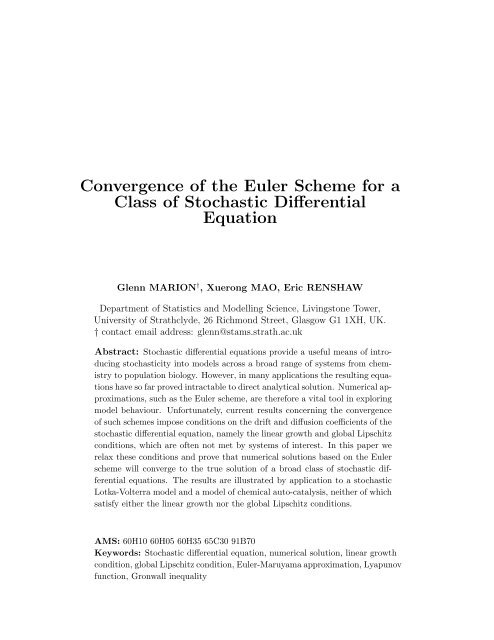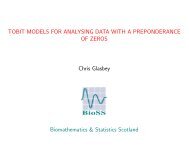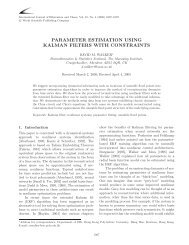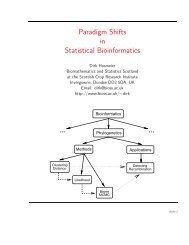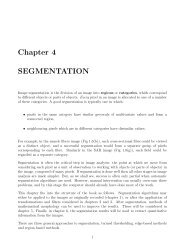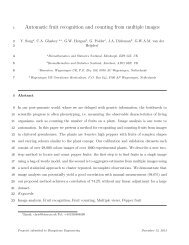Convergence of the Euler Scheme for a Class of Stochastic ...
Convergence of the Euler Scheme for a Class of Stochastic ...
Convergence of the Euler Scheme for a Class of Stochastic ...
Create successful ePaper yourself
Turn your PDF publications into a flip-book with our unique Google optimized e-Paper software.
<strong>Convergence</strong> <strong>of</strong> <strong>the</strong> <strong>Euler</strong> <strong>Scheme</strong> <strong>for</strong> a<br />
<strong>Class</strong> <strong>of</strong> <strong>Stochastic</strong> Differential<br />
Equation<br />
Glenn MARION † , Xuerong MAO, Eric RENSHAW<br />
Department <strong>of</strong> Statistics and Modelling Science, Livingstone Tower,<br />
University <strong>of</strong> Strathclyde, 26 Richmond Street, Glasgow G1 1XH, UK.<br />
† contact email address: glenn@stams.strath.ac.uk<br />
Abstract: <strong>Stochastic</strong> differential equations provide a useful means <strong>of</strong> introducing<br />
stochasticity into models across a broad range <strong>of</strong> systems from chemistry<br />
to population biology. However, in many applications <strong>the</strong> resulting equations<br />
have so far proved intractable to direct analytical solution. Numerical approximations,<br />
such as <strong>the</strong> <strong>Euler</strong> scheme, are <strong>the</strong>re<strong>for</strong>e a vital tool in exploring<br />
model behaviour. Un<strong>for</strong>tunately, current results concerning <strong>the</strong> convergence<br />
<strong>of</strong> such schemes impose conditions on <strong>the</strong> drift and diffusion coefficients <strong>of</strong> <strong>the</strong><br />
stochastic differential equation, namely <strong>the</strong> linear growth and global Lipschitz<br />
conditions, which are <strong>of</strong>ten not met by systems <strong>of</strong> interest. In this paper we<br />
relax <strong>the</strong>se conditions and prove that numerical solutions based on <strong>the</strong> <strong>Euler</strong><br />
scheme will converge to <strong>the</strong> true solution <strong>of</strong> a broad class <strong>of</strong> stochastic differential<br />
equations. The results are illustrated by application to a stochastic<br />
Lotka-Volterra model and a model <strong>of</strong> chemical auto-catalysis, nei<strong>the</strong>r <strong>of</strong> which<br />
satisfy ei<strong>the</strong>r <strong>the</strong> linear growth nor <strong>the</strong> global Lipschitz conditions.<br />
AMS: 60H10 60H05 60H35 65C30 91B70<br />
Keywords: <strong>Stochastic</strong> differential equation, numerical solution, linear growth<br />
condition, global Lipschitz condition, <strong>Euler</strong>-Maruyama approximation, Lyapunov<br />
function, Gronwall inequality
1 Introduction<br />
Consider stochastic differential equations (S.D.E.s) <strong>of</strong> <strong>the</strong> <strong>for</strong>m<br />
where<br />
dx(t) = f(x(t))dt + g(x(t))dB(t) (1.1)<br />
x = (x 1 , ..., x n ) T , f(x) = (f 1 (x), ..., f n (x)) T , g(x) = (g ij (x)) n×m<br />
and B(t) is an m-dimensional Brownian motion defined on a given complete<br />
probability space (Ω, F, P ) with a filtration {F t } t≥0 satisfying <strong>the</strong> usual conditions<br />
(i.e. it is right continuous and F 0 contains all P -null sets). The solution<br />
to (1.1), x(t), is a member <strong>of</strong> <strong>the</strong> open set G ⊆ R n <strong>for</strong> t ∈ [0, T ] and initial<br />
value x 0 ∈ G. That is, G is an invariant set <strong>of</strong> equation (1.1). We note that<br />
G is <strong>of</strong>ten <strong>the</strong> positive cone R n + ≡ {x ∈ R n : x > 0} or <strong>the</strong> whole Euclidean<br />
space R n . The solution x(t) is to be interpreted as <strong>the</strong> stochastic integral<br />
x(t) = x 0 +<br />
∫ t<br />
0<br />
f(x(s))ds +<br />
∫ t<br />
0<br />
g(x(s))dB(s), (1.2)<br />
in <strong>the</strong> Itô sense. Equation (1.1) represents one method in which stochasticity<br />
may be introduced into <strong>the</strong> deterministic model<br />
ẋ(t) = f(x(t)).<br />
In general, system (1.1) is analytically intractable (see <strong>for</strong> example Mao,<br />
1997), and <strong>the</strong>re<strong>for</strong>e numerical approximation schemes such as <strong>the</strong> <strong>Euler</strong> (or<br />
<strong>Euler</strong>-Maruyama) approximation are invaluable tools <strong>for</strong> exploring its properties.<br />
Most existing pro<strong>of</strong>s <strong>of</strong> <strong>the</strong> convergence <strong>of</strong> <strong>the</strong> such numerical schemes<br />
(Kloeden and Platen, 1992; Mao, 1997; Skokorod 1965) rely on <strong>the</strong> following<br />
conditions:<br />
(Linear growth) <strong>the</strong>re exists a positive constant L such that<br />
| f(x) | 2 ∨ | g(x) | 2 ≤ L(1+ | x | 2 ); (1.3)<br />
and, (Global Lipschitz) <strong>the</strong>re exists a positive constant ¯L such that<br />
| f(x) − f(y) | 2 ∨ | g(x) − g(y) | 2 ≤ ¯L | x − y | 2 (1.4)<br />
For all x ∈ R n .<br />
Un<strong>for</strong>tunately <strong>the</strong>se conditions are <strong>of</strong>ten not met by systems <strong>of</strong> interest.<br />
For example, consider <strong>the</strong> stochastic Lotka-Volterra model<br />
dx(t) = diag(x 1 , ..., x n (t)) [A(x(t) − ¯x)dt + σ(x(t) − ¯x)dB(t)] ; (1.5)
where<br />
x(t) = (x 1 , ..., x n (t)) T , ¯x = (¯x 1 , ..., ¯x n ) T , A = (a ij ) n×n , σ = (σ ij ) n×n ,<br />
and B(t) is now a scalar Brownian motion. This is <strong>of</strong> <strong>the</strong> <strong>for</strong>m (1.1) with<br />
f(x) = diag(x 1 , ..., x n )A(x − ¯x) and g(x) = diag(x 1 , ..., x n )σ(x − ¯x). It is<br />
straight<strong>for</strong>ward to see that nei<strong>the</strong>r <strong>the</strong> linear growth condition nor <strong>the</strong> global<br />
Lipschitz condition will be satisfied by this system. The properties <strong>of</strong> <strong>the</strong> solution<br />
x(t) = x(t; x 0 ) to equation (1.5) are discussed in detail by Mao, Marion<br />
and Renshaw (2000). Here we discuss numerical approximations to a class<br />
<strong>of</strong> S.D.E.s including this system, but note that our approach developed from<br />
initial studies <strong>of</strong> <strong>the</strong> numerical solutions <strong>of</strong> (1.5). In particular, we show that<br />
under certain conditions, weaker than (1.3) and (1.4), <strong>the</strong> <strong>Euler</strong> scheme applied<br />
to system (1.1), converges to <strong>the</strong> analytic solution x(t), and in doing so<br />
bound <strong>the</strong> order <strong>of</strong> this approximation. We note that o<strong>the</strong>rs have also weakened<br />
<strong>the</strong>se conditions. Yamada (1978) relaxed <strong>the</strong> global Lipschitz condition,<br />
whilst Kaneko and Nakao (1988) have shown that <strong>the</strong> <strong>Euler</strong> approximation<br />
converges, in <strong>the</strong> strong sense, to <strong>the</strong> solution <strong>of</strong> <strong>the</strong> stochastic differential<br />
equation whenever path-wise uniqueness <strong>of</strong> <strong>the</strong> solution holds. However, both<br />
results require <strong>the</strong> linear growth condition whilst <strong>the</strong> latter provides no in<strong>for</strong>mation<br />
on <strong>the</strong> order <strong>of</strong> approximation.<br />
In Section 2 <strong>the</strong> <strong>Euler</strong> approximation is introduced and we state Theorem<br />
1, namely that, under certain conditions, <strong>the</strong> <strong>Euler</strong> approximate solution converges<br />
to <strong>the</strong> true solution <strong>for</strong> system (1.1). This result is proved in Sections 3,<br />
4 and 5. Section 3 demonstrates that <strong>the</strong> <strong>Euler</strong> approximate solution will converge<br />
to <strong>the</strong> true solution x(t) if both remain within a compact set. A compact<br />
set appropriate to our needs is introduced in Section 4; <strong>the</strong> escape times from<br />
this set, both <strong>of</strong> x(t) and <strong>the</strong> approximate solution, are bounded in probability.<br />
These results are brought toge<strong>the</strong>r in Section 5 to prove our convergence<br />
result <strong>of</strong> Theorem 1. Finally, Section 6 applies this result to two interesting<br />
models, namely <strong>the</strong> Lotka-Volterra system (1.5) and a model describing an<br />
auto-catalytic reaction system.<br />
2 The <strong>Euler</strong> Approximation<br />
For system (1.1) <strong>the</strong> discrete time <strong>Euler</strong> approximation on t ∈ {0, ∆t, ..., N∆t =<br />
T } is given by <strong>the</strong> iterative scheme<br />
x ∆t (t + ∆t) = x ∆t (t) + f(x ∆t (t))∆t + g(x ∆t (t))∆B(t) (2.1)<br />
with initial value x ∆t (0) = x 0 . Here <strong>the</strong> time increment is ∆t, and <strong>the</strong> ∆B(t) =<br />
B(t + ∆t) − B(t) represent N independent draws from an m-dimensional Normal<br />
distribution whose individual components have mean zero and variance
∆t. We will prove <strong>the</strong> following useful convergence result.<br />
Theorem 1 Let G be an open subset <strong>of</strong> R n , and denote <strong>the</strong> unique solution<br />
<strong>of</strong> (1.1) <strong>for</strong> t ∈ [0, T ] given x 0 ∈ G by x(t) ∈ G. Define x ∆t (t) as <strong>the</strong> <strong>Euler</strong><br />
approximation (2.1) and let D ⊆ G be any compact set. Suppose <strong>the</strong> following<br />
conditions are satisfied:<br />
(i) (local Lipschitz condition) <strong>the</strong>re exists a positive constant K 1 (D) such<br />
that x, y ∈ D<br />
| f(x) − f(y) | 2 ∨ | g(x) − g(y) | 2 ≤ K 1 (D) | x − y | 2 ;<br />
(ii) <strong>the</strong>re exists a C 2 -function V : G → R + such that {x ∈ G : V (x) ≤ r}<br />
is compact <strong>for</strong> any r > 0;<br />
(iii) LV (x) ≤ K(1 + V (x)) where<br />
LV (x) ≡ V x (x)f(x) + 1 2 trace [ g T (x)V xx (x)g(x) ]<br />
is <strong>the</strong> diffusion operator associated with (1.1);<br />
(iv) <strong>the</strong>re exists a positive constant K 3 (D) such that <strong>for</strong> all x, y ∈ D<br />
| V (x) − V (y) | ∨ | V x (x) − V x (y) | ∨ | V xx (x) − V xx (y) |≤ K 3 (D) | x − y | .<br />
Then <strong>for</strong> any ɛ, δ > 0 <strong>the</strong>re exists ∆t ∗ > 0 such that<br />
Pr<br />
(<br />
sup | x ∆t (t) − x(t) | 2 ≥ δ<br />
0≤t≤T<br />
provided ∆t ≤ ∆t ∗ and <strong>the</strong> initial value x 0 ∈ G.<br />
)<br />
≤ ɛ,<br />
In order to prove this result it is useful to note that if condition (i) holds<br />
<strong>the</strong>n <strong>the</strong>re exists a positive constant K 2 (D) such that <strong>for</strong> x, y ∈ D<br />
| f(x) | 2 ∨ | g(x) | 2 ≤ K 2 (D). (2.2)<br />
Fur<strong>the</strong>rmore, we shall rewrite x ∆t (t) as <strong>the</strong> integral<br />
x ∆t (t) = x 0 +<br />
∫ t<br />
0<br />
f(ˆx ∆t (s))ds +<br />
where we have introduced <strong>the</strong> piecewise constant process<br />
∫ t<br />
0<br />
g(ˆx ∆t (s))dB(s), (2.3)<br />
ˆx ∆t (t) = Σ N k=1x ∆t ((k − 1)∆t)I [(k−1)∆t,k∆t] (t), (2.4)
and I A is <strong>the</strong> indicator function <strong>for</strong> set A. Expression (2.3) extends <strong>the</strong> definition<br />
<strong>of</strong> <strong>the</strong> <strong>Euler</strong> scheme to all t ∈ [0, T ], and may also be expressed in <strong>the</strong><br />
stochastic differential <strong>for</strong>m<br />
dx ∆t (t) = f(ˆx ∆t (t))dt + g(ˆx ∆t (t))dB(t), (2.5)<br />
with initial condition x ∆t (0) = x 0 ∈ G.<br />
3 <strong>Convergence</strong> <strong>of</strong> <strong>the</strong> <strong>Euler</strong> scheme<br />
To proceed we consider only trajectories x(t) and x ∆t (t) which remain within<br />
a bounded region D. To achieve this, introduce <strong>the</strong> stopping time τ = ρ ∧ θ<br />
where<br />
ρ = inf{t ≥ 0 : x ∆t (t) /∈ D} and θ = inf{t ≥ 0 : x(t) /∈ D}<br />
are <strong>the</strong> first times that x ∆t (t) and x(t), respectively, leave D. We will define<br />
D more precisely later.<br />
Let T 1 ∈ [0, T ] be an arbitrary time. Then subtracting (1.2) from (2.3),<br />
applying <strong>the</strong> inequality | a + b | 2 ≤ 2 | a | 2 +2 | b | 2 , taking <strong>the</strong> supremum over<br />
t ∈ [0, τ ∧ T 1 ], and <strong>the</strong>n finally <strong>the</strong> expectation, leads to<br />
[<br />
]<br />
∫ t<br />
E sup |x ∆t (t)−x(t)| 2 ≤ 2E sup | [f(ˆx ∆t (s) − f(x(s))] ds| 2 (3.1)<br />
0≤t≤τ∧T 1 0≤t≤τ∧T 1 0<br />
∫ t<br />
+ 2E sup | [g(ˆx ∆t (s)) − g(x(s))] dB(s)| 2 .<br />
0≤t≤τ∧T 0<br />
The Hölder inequality shows that<br />
∫ t<br />
∫<br />
2E sup | [f(ˆx ∆t (s))−f(x(s))]ds| 2 τ∧T1<br />
≤ 2T E |f(ˆx ∆t (s)−f(x(s))| 2 ds, (3.2)<br />
0≤t≤τ∧T 1 0<br />
0<br />
whence applying <strong>the</strong> well-known Doob inequality (c.f. Theorem 1.7.2, Mao,<br />
1997) to <strong>the</strong> second term <strong>of</strong> (3.1) leads to<br />
∫ t<br />
∫<br />
2E sup | [g(ˆx ∆t (s))−g(x(s))]dB(s)| 2 τ∧T1<br />
≤ 8 E |g(ˆx ∆t (s))−g(x(s))| 2 ds.(3.3)<br />
0≤t≤τ∧T 1 0<br />
0<br />
If <strong>the</strong> coefficients <strong>of</strong> (1.1) are locally Lipschitz continuous (i.e. satisfy condition<br />
(i) <strong>of</strong> Theorem 1), <strong>the</strong>n since both x(s) and x ∆t (s) are bounded we may write<br />
|f(ˆx ∆t (s)−f(x(s))| 2 ∨ |g(ˆx ∆t (s)−g(x(s))| 2 ≤ K 1 (D)| ˆx ∆t (s)−x(s)| 2 (3.4)
<strong>for</strong> s ∈ [0, τ ∧ T 1 ]. Substituting (3.2), (3.3) and (3.4) into (3.1) <strong>the</strong>n reveals<br />
that<br />
[<br />
]<br />
E sup | x ∆t (t) − x(t) | 2<br />
0≤t≤τ∧T 1<br />
≤<br />
2K 1 (D)(T + 4) E<br />
= 2K 1 (D)(T + 4) E<br />
≤<br />
≤<br />
4K 1 (D)(T + 4) E<br />
4K 1 (D)(T + 4) E<br />
∫ τ∧T1<br />
0<br />
∫ τ∧T1<br />
0<br />
∫ τ∧T1<br />
0<br />
∫ τ∧T1<br />
∫ T1<br />
+4K 1 (D)(T + 4)<br />
0<br />
0<br />
E<br />
| ˆx ∆t (s) − x(s) | 2 ds<br />
| ˆx ∆t (s) − x ∆t (s) + x ∆t (s) − x(s) | 2 ds<br />
(<br />
| ˆx∆t (s) − x ∆t (s) | 2 + | x ∆t (s) − x(s) | 2) ds<br />
| ˆx ∆t (s) − x ∆t (s) | 2 ds<br />
[<br />
]<br />
sup | x ∆t (s ′ ) − x(s ′ ) | 2 ds. (3.5)<br />
0≤s ′ ≤τ∧s<br />
Bounding <strong>the</strong> first term on <strong>the</strong> right-hand side <strong>of</strong> (3.5) and <strong>the</strong>n applying<br />
<strong>the</strong> Gronwall inequality leads to a bound on E [ sup 0≤t≤τ∧T | x ∆t (t) − x(t) | 2] .<br />
Inspection <strong>of</strong> (2.4) reveals that ˆx ∆t (s) = x ∆t ([s/∆t]∆t) where [s/∆t] is <strong>the</strong><br />
integer part <strong>of</strong> s/∆t. We can now use (2.3) to show that<br />
| ˆx ∆t (s)−x ∆t (s)| 2 =|x ∆t ([s/∆t]∆t)−x ∆t (s)| 2<br />
= |<br />
∫ s<br />
[s/∆t]∆t<br />
f(x ∆t ([s/∆t]∆t))du +<br />
∫ s<br />
[s/∆t]∆t<br />
g(x ∆t ([s/∆t]∆t))dB(u)| 2<br />
≤ 2 |f(x ∆t ([s/∆t]∆t))| 2 ∆t 2 + 2|g(x ∆t ([s/∆t]∆t))| 2 |B(s) − B([s/∆t]∆t)| 2<br />
≤ 2K 2 (D)∆t 2 + 2K 2 (D) |B(s)−B([s/∆t]∆t)| 2 .<br />
Note that <strong>the</strong> last line follows provided s ∈ [0, τ ∧T 1 ] and condition (2.2) holds.<br />
If T ∆t < 1 this inequality leads to<br />
∫ τ∧T1<br />
E<br />
0<br />
| ˆx ∆t (s)−x ∆t (s)| 2 ds ≤ 2K 2 (D)T 1 ∆t 2<br />
≤<br />
∫ T1<br />
+2K 2 (D) E |B(s)−B([s/∆t]∆t)| 2 ds<br />
0<br />
2K 2 (D)T ∆t 2 + 2K 2 (D)T 1 m∆t<br />
≤ 2K 2 (D)(mT + 1)∆t (3.6)<br />
(recall that our Brownian motion has dimension m). Using this result in (3.5)<br />
shows that<br />
[<br />
]<br />
E sup |x ∆t (t)−x(t)| 2 ≤ C 1 (D)∆t<br />
0≤t≤τ∧T 1<br />
∫ [<br />
T1<br />
+ C 2 (D) E<br />
0<br />
]<br />
sup |x ∆t (r)−x(r)| 2 ds<br />
0≤r≤τ∧s
where C 1 (D) = 8K 1 (D)K 2 (D)(T + 4)(mT + 1) and C 2 (D) = 4K 1 (D)(T + 4).<br />
On applying <strong>the</strong> Gronwall inequality we <strong>the</strong>n have <strong>the</strong> following <strong>the</strong>orem.<br />
Theorem 2 If τ is <strong>the</strong> first exit time <strong>of</strong> ei<strong>the</strong>r <strong>the</strong> solution x(t) or <strong>the</strong><br />
<strong>Euler</strong> approximate solution x ∆t (t) from a bounded region D, and f(x) and<br />
g(x) satisfy condition (i) <strong>of</strong> Theorem 1, <strong>the</strong>n <strong>for</strong> ∆tT < 1<br />
[<br />
]<br />
E sup | x ∆t (t) − x(t) | 2 ≤ C 1 (D)e C2(D)T ∆t = C(D)∆t.<br />
0≤t≤τ∧T<br />
Thus, as long as x ∆t (t) and x(t) remain in D <strong>the</strong> <strong>Euler</strong> scheme x ∆t (t) converges<br />
to <strong>the</strong> solution x(t) <strong>of</strong> equation (1.1) as ∆t → 0.<br />
4 Characterising stopping times<br />
To proceed fur<strong>the</strong>r we define <strong>the</strong> bounded domain<br />
D = D(r) ≡ {x ∈ G such that V (x) ≤ r}.<br />
In order to prove Theorem 1 we will determine <strong>the</strong> probability that both x ∆t (t)<br />
and x(t) remain in D(r). To do so we assume <strong>the</strong> existence <strong>of</strong> <strong>the</strong> non-negative<br />
function V (x) satisfying condition (ii) <strong>of</strong> Theorem 1. Since x(t) is governed by<br />
equation (1.1), applying Itô’s <strong>for</strong>mula to V (x(t)) yields<br />
dV (x(t)) = LV (x(t)) + V x (x(t))g(x(t))dB(t).<br />
Integrating from 0 to t ∧ θ and taking expectations gives<br />
E[V (x(t ∧ θ)] = V (x 0 ) + E<br />
∫ t∧θ<br />
0<br />
LV (x(s))ds.<br />
Whence applying condition (iii) <strong>of</strong> Theorem 1 leads to<br />
∫ t∧θ<br />
E[V (x(t ∧ θ)] ≤ V (x 0 ) + KE (1 + V (x(s)))ds.<br />
≤ (V (x 0 ) + KT ) +<br />
0<br />
∫ t<br />
≤ (V (x 0 ) + KT )e KT .<br />
0<br />
E[V (x(s ∧ θ))]ds<br />
The last line follows on application <strong>of</strong> <strong>the</strong> Gronwall inequality. On noting that<br />
V (x(θ)) = r, since x(θ) is on <strong>the</strong> boundary <strong>of</strong> D(r), <strong>the</strong> probability p(θ < T )<br />
can now be bounded as follows.<br />
(V (x 0 ) + KT )e KT ≥ E[V (x(t ∧ θ)]<br />
≥<br />
≥<br />
E[V (x(θ))I {θ
whence rearranging (4.1) leads to<br />
P (θ < T ) ≤ (V (x 0 ) + KT )e KT /r = ˜ɛ. (4.2)<br />
Here r can be made as large as required, <strong>for</strong> a given T and x 0 , to accommodate<br />
any ˜ɛ ∈ (0, 1). Theorem 3 now follows immediately.<br />
Theorem 3 If θ is <strong>the</strong> first exit time <strong>of</strong> <strong>the</strong> solution x(t) to equation (1.1)<br />
from <strong>the</strong> domain D(r), and a function V (x) exists which satisfies conditions<br />
(ii) and (iii) <strong>of</strong> Theorem 1, <strong>the</strong>n<br />
P(θ ≥ T ) ≥ 1 − ˜ɛ.<br />
We note that <strong>the</strong> following useful result follows directly from Theorem 3.<br />
Lemma 4 Let θ be <strong>the</strong> first exit time <strong>of</strong> <strong>the</strong> solution x(t) to equation (1.1)<br />
from <strong>the</strong> domain D(r), and let <strong>the</strong> coefficients <strong>of</strong> (1.1) satisfy condition (i) <strong>of</strong><br />
Theorem 1. If a function V (x) exists which satisfies conditions (ii) and (iii) <strong>of</strong><br />
Theorem 1, <strong>the</strong>n <strong>the</strong> limit <strong>of</strong> lim r→∞ D(r) ≡ G and, <strong>for</strong> t ∈ [0, T ] and x 0 ∈ G,<br />
x(t) remains in G. Fur<strong>the</strong>rmore, x(t) is <strong>the</strong> unique solution <strong>of</strong> equation (1.1)<br />
on t ∈ [0, T ] <strong>for</strong> all finite T .<br />
In order to prove this, first note that if <strong>the</strong> coefficients <strong>of</strong> (1.1) are locally<br />
Lipschitz continuous <strong>the</strong>n <strong>the</strong>re exists a unique local solution x(t) on<br />
t ∈ [0, τ e ] where τ e is some random explosion time (cf. Arnold, 1972 or Mao,<br />
1997). Since D(r) is an increasing set (with r) lim r→∞ D(r) = ⋃ ∞<br />
r=1 D(r) ⊆ G.<br />
Suppose that lim r→∞ D(r) ≢ G, <strong>the</strong>n <strong>the</strong>re exists some x ∈ G such that<br />
x /∈ ⋃ ∞<br />
r=1 D(r). However, if x ∈ G <strong>the</strong>n V (x) < ∞ and <strong>the</strong>re exists an r > 0<br />
such that V (x) < r, which implies that x ∈ ⋃ ∞<br />
r=1 D(r) and <strong>the</strong>re<strong>for</strong>e that<br />
lim r→∞ D(r) ≡ G. Now by Theorem 3 <strong>the</strong> probability <strong>of</strong> escape from <strong>the</strong> set<br />
lim r→∞ D(r) in any finite T is zero. Thus x(t) must remain in G <strong>for</strong> any finite<br />
time, and lim r→∞ D(r) identifies <strong>the</strong> invariant set G ⊆ R n <strong>of</strong> Theorem 1. Since<br />
G ⊆ R n , this implies <strong>the</strong>re will be no explosion in any finite time, and so x(t)<br />
is unique on any finite interval t ∈ [0, T ].<br />
We require a similar result to Theorem 3 <strong>for</strong> <strong>the</strong> <strong>Euler</strong> approximate solutions<br />
x ∆t (t). Noting that x ∆t (t) is <strong>the</strong> solution to (2.5), and applying <strong>the</strong> Itô<br />
<strong>for</strong>mula to V (x ∆t (t)) yields,<br />
dV (x ∆t (t)) =<br />
[<br />
V x (x ∆t (t))f(ˆx ∆t (t)) + 1 ]<br />
2 gT (ˆx ∆t (t))V xx (x ∆t (t))g(ˆx ∆t (t)) dt<br />
+ V x (x ∆t (t))g(ˆx ∆t (t))dB(t)<br />
= LV (ˆx ∆t (t)) + [V x (x ∆t (t)) − V x (ˆx ∆t (t))] f(ˆx ∆t (t))dt
+ 1 2 gT (ˆx ∆t (t)) [V xx (x ∆t (t)) − V xx (ˆx ∆t (t))] g(ˆx ∆t (t))dt<br />
+ V x (x ∆t (t))g(ˆx ∆t (t))dB(t).<br />
Whence on applying condition (iii) <strong>of</strong> Theorem 1 we obtain<br />
dV (x ∆t (t)) ≤ K (1 + V (ˆx ∆t (t))) + [V x (x ∆t (t)) − V x (ˆx ∆t (t))] f(ˆx ∆t (t))dt<br />
≤<br />
+ 1 2 gT (ˆx ∆t (t)) [V xx (x ∆t (t)) − V xx (ˆx ∆t (t))] g(ˆx ∆t (t))dt<br />
+ V x (x ∆t (t))g(ˆx ∆t (t))dB(t)<br />
K (1 + V (x ∆t (t))) dt + K [V (ˆx ∆t (t)) − V (x ∆t (t))] dt<br />
+ [V x (x ∆t (t)) − V x (ˆx ∆t (t))] f(ˆx ∆t (t))dt<br />
+ 1 2 gT (ˆx ∆t (t)) [V xx (x ∆t (t)) − V xx (ˆx ∆t (t))] g(ˆx ∆t (t))dt<br />
+ V x (x ∆t (t))g(ˆx ∆t (t))dB(t).<br />
Integrating from 0 to ρ ∧ t and taking expectations gives<br />
E[V (x ∆t (ρ ∧ t))] ≤ V (x 0 ) + KE<br />
+ KE<br />
+ E<br />
∫ ρ∧t<br />
0<br />
∫ ρ∧t<br />
0<br />
∫ ρ∧t<br />
0<br />
(1 + V (x ∆t (s))) ds<br />
[V (ˆx ∆t (s)) − V (x ∆t (s))] ds<br />
[V x (x ∆t (s)) − V x (ˆx ∆t (s))] f(ˆx ∆t (s))ds<br />
+ 1 ∫ ρ∧t<br />
2 E g T (ˆx ∆t (s)) [V xx (x ∆t (s))−V xx (ˆx ∆t (s))] g(ˆx ∆t (s))ds<br />
0<br />
≤ V (x 0 ) + KT + K<br />
+ KE<br />
+ E<br />
∫ ρ∧t<br />
0<br />
∫ ρ∧t<br />
0<br />
∫ t<br />
0<br />
E[V (x ∆t (s ∧ ρ))]ds<br />
| V (ˆx ∆t (s)) − V (x ∆t (s)) | ds<br />
| V x (x ∆t (s)) − V x (ˆx ∆t (s)) || f(ˆx ∆t (s)) | ds<br />
+ 1 ∫ ρ∧t<br />
2 E | g(ˆx ∆t (s)) | 2 |V xx (x ∆t (s))−V xx (ˆx ∆t (s))| ds,<br />
0<br />
and invoking (2.2) and condition (iv) <strong>of</strong> Theorem 1 leads to<br />
E[V (x ∆t (ρ ∧ t))] ≤ V (x 0 ) + KT + ( K + K 1/2<br />
2 (D) + K 2 (D)/2 )<br />
∫ ρ∧t<br />
× K 3 (D) E | ˆx ∆t (s)−x ∆t (s)| ds<br />
+ K<br />
∫ t<br />
0<br />
0<br />
E[V (x ∆t (ρ ∧ s))]ds.<br />
The bound<br />
∫ ρ∧t<br />
E | ˆx ∆t (s)−x ∆t (s)| ds ≤ (2K 2 (D)T (mT + 1)) 1/2 ∆t 1/2 ,<br />
0
follows from Hölders inequality and equation (3.6) <strong>for</strong> t ∈ [0, T ] and ∆tT < 1.<br />
Thus<br />
E[V (x ∆t (ρ ∧ t))] ≤ V (x 0 ) + KT + ( K + K 1/2<br />
2 (D) + K 2 (D)/2 )<br />
× K 3 (D) (2K 2 (D)T (mT + 1)) 1/2 ∆t 1/2<br />
+ K<br />
∫ t<br />
Whence, on applying <strong>the</strong> Gronwall inequality,<br />
0<br />
E[V (x ∆t (s ∧ ρ))]ds.<br />
E[V (x ∆t (ρ ∧ T ))] ≤ (V (x 0 ) + KT ) e KT + H(D)∆t 1/2 ,<br />
where H(D) = e KT (K + K 1/2<br />
2 (D) + K 2 (D)/2)K 3 (D) (2K 2 (D)T (mT + 1)) 1/2 .<br />
An argument analogous to that used to prove Theorem 3 can now be used to<br />
bound P (ρ < T ). Since x ∆t (ρ) is on <strong>the</strong> boundary <strong>of</strong> D(r) <strong>the</strong>n V (x ∆t (ρ)) = r<br />
which leads to<br />
(V (x 0 ) + KT ) e KT + H(D)∆t 1/2 ≥ E[V (x(ρ ∧ T ))]<br />
≥<br />
≥<br />
E[V (x(ρ))I {ρ
5 <strong>Convergence</strong> in probability<br />
Introducing <strong>the</strong> event sub-space<br />
and using Theorem 2, we find that<br />
C(D)∆t ≥ E<br />
¯Ω = {ω : sup | x ∆t (t) − x(t) | 2 ≥ δ},<br />
0≤t≤T<br />
≥<br />
E<br />
[<br />
sup<br />
0≤t≤τ∧T<br />
[<br />
I {τ≥T } (ω) sup<br />
| x ∆t (t) − x(t) | 2 ]<br />
0≤t≤T<br />
| x ∆t (t) − x(t) | 2 ]<br />
[<br />
]<br />
≥ E I {τ≥T } (ω)I {¯Ω} (ω) sup | x ∆t (t) − x(t) | 2<br />
0≤t≤T<br />
≥ δ E [ I {τ≥T } (ω)I {¯Ω} (ω) ]<br />
= δ P ( (τ ≥ T ) ∩ ¯Ω )<br />
≥ δ [ P (¯Ω) − P (τ < T )<br />
]<br />
.<br />
Whence on using (4.3) we conclude that<br />
P (¯Ω) (<br />
)<br />
= P sup | x ∆t (t) − x(t) | 2 ≥ δ<br />
0≤t≤T<br />
≤<br />
2˜ɛ + ˜ɛ ¯H(D)∆t 1/2 + C(D) ∆t<br />
δ<br />
which, <strong>for</strong> appropriate choice <strong>of</strong> ∆t, proves Theorem 1. It is clear that to<br />
increase <strong>the</strong> precision δ <strong>the</strong>n ∆t should be reduced. However, it is interesting<br />
to note that to leading order <strong>the</strong> bound on P (¯Ω) is independent <strong>of</strong> δ. Fur<strong>the</strong>rmore,<br />
to achieve a given precision with increased probability, ∆t should<br />
also be reduced. This is because <strong>the</strong> domain D(r) grows as ˜ɛ is reduced (recall<br />
that r ∝ 1/˜ɛ), and in general ¯H(D) and C(D) will increase with <strong>the</strong> size <strong>of</strong><br />
<strong>the</strong> domain.<br />
6 Two particular models<br />
6.1 Lotka-Volterra model<br />
For <strong>the</strong> Lotka-Volterra system (1.5) <strong>the</strong> functions f(x) and g(x) satisfy condition<br />
(i) <strong>of</strong> Theorem 1. Mao et al. (2000) show that a suitable Lyapunov<br />
function <strong>for</strong> this system is<br />
V (x) = Σ n i=1c i¯x i h (x i /¯x i ) where h(u) = u − 1 − ln(u), (6.1)
<strong>for</strong> n positive constants c 1 , ..., c n . This function satisfies conditions (ii) and<br />
(iv) <strong>of</strong> Theorem 1, whilst it is straight<strong>for</strong>ward to show that<br />
where<br />
LV (x) = − 1 2 (x(t) − ¯x)T H(x(t) − ¯x) (6.2)<br />
H = −CA − A T C − σ T diag((c 1¯x 1 , ..., c n¯x n )σ (6.3)<br />
and C = diag(c 1 , ..., c n ). Thus, if <strong>the</strong> n positive constants c 1 , ..., c n can be found<br />
such that <strong>the</strong> symmetric matrix H is non-negative definite <strong>the</strong>n it follows that<br />
LV (x) ≤ 0 and condition (iii) <strong>of</strong> Theorem 1 is satisfied. Finally, we note<br />
that under this condition, Theorem 1 <strong>of</strong> Mao et al. (2000) shows that <strong>for</strong> any<br />
x 0 ∈ R+ n = {x ∈ R 2 : x i > 0 <strong>for</strong> all 1 ≤ i ≤ n} x(t) ∈ R+ n <strong>for</strong> all t ≥ 0 almost<br />
surely, and fur<strong>the</strong>rmore that x(t) is unique. There<strong>for</strong>e, when H is non-negative<br />
definite <strong>for</strong> any x 0 ∈ R+, 2 <strong>the</strong> <strong>Euler</strong> scheme will converge to <strong>the</strong> true solution <strong>of</strong><br />
(1.5) in <strong>the</strong> sense <strong>of</strong> Theorem 1, provided that <strong>the</strong> time step ∆t is sufficiently<br />
small. Mao et al. (2000) make extensive use <strong>of</strong> simulations <strong>of</strong> (1.5) to confirm<br />
analytic results and to explore model behaviour in regimes not amenable to<br />
analysis. Since <strong>the</strong>se simulations are based on <strong>the</strong> <strong>Euler</strong> scheme <strong>the</strong> results <strong>of</strong><br />
this section support <strong>the</strong> numerical results in that earlier paper.<br />
6.2 The Quadratic Autocatylator<br />
Many catalytic systems can be <strong>for</strong>mulated in terms <strong>of</strong> S.D.E.s. One such<br />
example is <strong>the</strong> quadratic autocatylator which models <strong>the</strong> catalytic reaction<br />
A + B → 2B.<br />
If <strong>the</strong>se reactions occur in a large volume, in well mixed conditions and in <strong>the</strong><br />
absence <strong>of</strong> environmental noise, <strong>the</strong>n <strong>the</strong> concentrations <strong>of</strong> A and B particles,<br />
α(t) and β(t), may be described by <strong>the</strong> deterministic equations (Marion et al.<br />
2000)<br />
dα(t)/dt = (α 0 − α(t))ν − κα(t)β(t)<br />
dβ(t)/dt = κα(t)β(t) − (K b + ν)β(t)<br />
where <strong>the</strong> parameters α 0 , κ, K b , ν ≥ 0. There are many ways in which environmental<br />
noise may be introduced into this system, but one simple approach<br />
is to assume that <strong>the</strong> parameter K b → K b + σḂ(t) is perturbed by noise. This<br />
gives rise to <strong>the</strong> stochastic differential system<br />
dα(t) = [(α 0 − α(t))ν − κα(t)β(t)]dt (6.4)<br />
dβ(t) = [κα(t)β(t) − (K b + ν)β(t)]dt + σβ(t)dB(t).
The drift and diffusion terms satisfy condition (i) <strong>of</strong> Theorem 1. In this case<br />
define<br />
V (α, β) = h (α) + h (β) where, as be<strong>for</strong>e, h(u) = u − 1 − ln(u). (6.5)<br />
Then it is straight<strong>for</strong>ward to see that <strong>for</strong> (α, β) ∈ R 2 +, V (α, β) satisfies condition<br />
(iii) <strong>of</strong> <strong>the</strong>orem 1 since,<br />
LV (α, β) ≤ ( να 0 + 2ν + K b + σ 2 /2 ) + kβ<br />
≤<br />
K(1 + V (α, β)).<br />
Moreover, (6.5) also satisfies conditions (ii) and (iv) <strong>of</strong> Theorem 1. So in order<br />
to prove convergence it is sufficient to show that <strong>for</strong> any (α(0), β(0)) ∈ R 2 + <strong>the</strong><br />
solution (α(t), β(t)) remains in R 2 + <strong>for</strong> t ∈ [0, T ] <strong>for</strong> all T > 0. To achieve this<br />
we note that <strong>the</strong> limit, as r → ∞, <strong>of</strong><br />
D(r) ≡ {(α, β) ∈ R 2 such that V (α, β) ≤ r},<br />
is lim r→∞ D(r) = R 2 +. Thus, applying Lemma 4 we find that <strong>for</strong> finite T ,<br />
t ∈ [0, T ] and (α(0), β(0)) ∈ R 2 + <strong>the</strong> solution (α(t), β(t)) remains in R 2 + and is<br />
unique. So, <strong>the</strong> <strong>Euler</strong> approximate solution will converge to <strong>the</strong> true solution<br />
<strong>of</strong> (6.4) <strong>for</strong> any (α(0), β(0)) ∈ R 2 + in <strong>the</strong> sense <strong>of</strong> <strong>the</strong>orem 1, provided ∆t is<br />
sufficiently small. Marion et al. (2000) employ <strong>the</strong> <strong>Euler</strong> scheme to study<br />
auto-catalytic systems <strong>of</strong> <strong>the</strong> type considered here. The results <strong>of</strong> this paper<br />
support this numerical approach.<br />
7 Discussion<br />
We have shown that under <strong>the</strong> conditions <strong>of</strong> Theorem 1 <strong>the</strong> <strong>Euler</strong> approximate<br />
solutions will converge to <strong>the</strong> true solutions <strong>of</strong> (1.1) with large probability,<br />
provided that <strong>the</strong> time step is sufficiently small. Fur<strong>the</strong>rmore, under <strong>the</strong> same<br />
conditions Lemma 4 identifies an invariant set <strong>of</strong> <strong>the</strong> stochastic differential<br />
equation (1.1) and shows that its solutions are unique up to any finite time.<br />
However, <strong>the</strong>re are a number <strong>of</strong> ways in which one might improve upon <strong>the</strong>se<br />
results. One possible extension would be to widen <strong>the</strong> applicability <strong>of</strong> <strong>the</strong>orem<br />
1 to a non-autonomous system<br />
dx(t) = f(x(t), t)dt + g(x(t), t)dB(t).<br />
However, <strong>the</strong> key difficulty in applying Theorem 1 is in identifying a function<br />
V appropriate to a given system and this might become considerably easier<br />
if less stringent conditions could be imposed on V . Finally, whilst we have
ounded <strong>the</strong> order <strong>of</strong> approximation achieved by <strong>the</strong> <strong>Euler</strong> scheme it would<br />
also be very useful to obtain a more accurate estimate <strong>of</strong> <strong>the</strong> approximation<br />
error. We hope to address <strong>the</strong>se issues in subsequent work.<br />
Acknowledgements<br />
The authors gratefully acknowledge <strong>the</strong> support <strong>of</strong> <strong>the</strong> BBSRC and <strong>the</strong><br />
EPSRC, U.K.<br />
References<br />
1. L. Arnold, <strong>Stochastic</strong> Differential Equations: Theory and Applications, Wiley<br />
(1972).<br />
2. T. Kaneko and S. Nakao, A Note on Approximation <strong>for</strong> <strong>Stochastic</strong> Differential<br />
Equations, Séminaire de Probabilitiés 22, Lect. Notes Math., 1321<br />
(1988), 155-162.<br />
3. P. E. Kloeden and E. Platen, Numerical Solution <strong>of</strong> <strong>Stochastic</strong> Differential<br />
Equations , Springer-Verlag (1992).<br />
4. X. Mao, <strong>Stochastic</strong> Differential Equations and Applications, Horwood (1997).<br />
5. X. Mao, G. Marion, and E. Renshaw, <strong>Stochastic</strong> Lotka-Volterra model,<br />
submitted to J. Appl. Prob. (2000)<br />
6. G. Marion, X. Mao and E. Renshaw, Noise induced transitions in <strong>the</strong><br />
quadratic autocatylator, in preparation (2000).<br />
7. A. V. Skorohod, Studies in <strong>the</strong> Theory <strong>of</strong> Random Processes , Addison-<br />
Wisely (1965).<br />
8. T. Yamada, Sur une construction des solutions d’équations différentielles<br />
stochastiques des les cas non-Lipschitzien, Séminaire de Probabilitiés 12,<br />
Lect. Notes Math., 649 (1978), 114-131.


